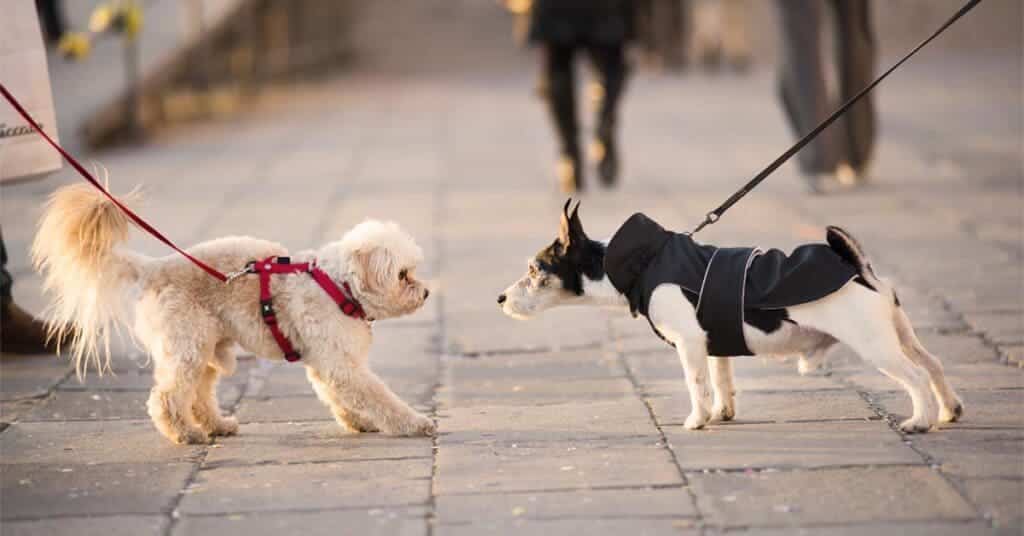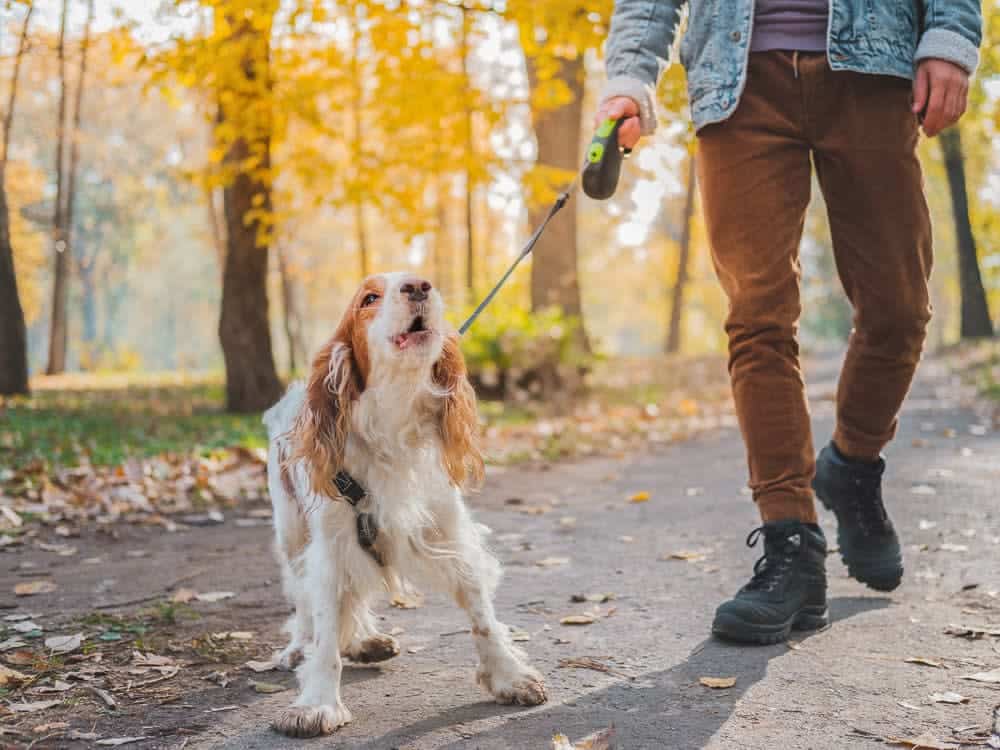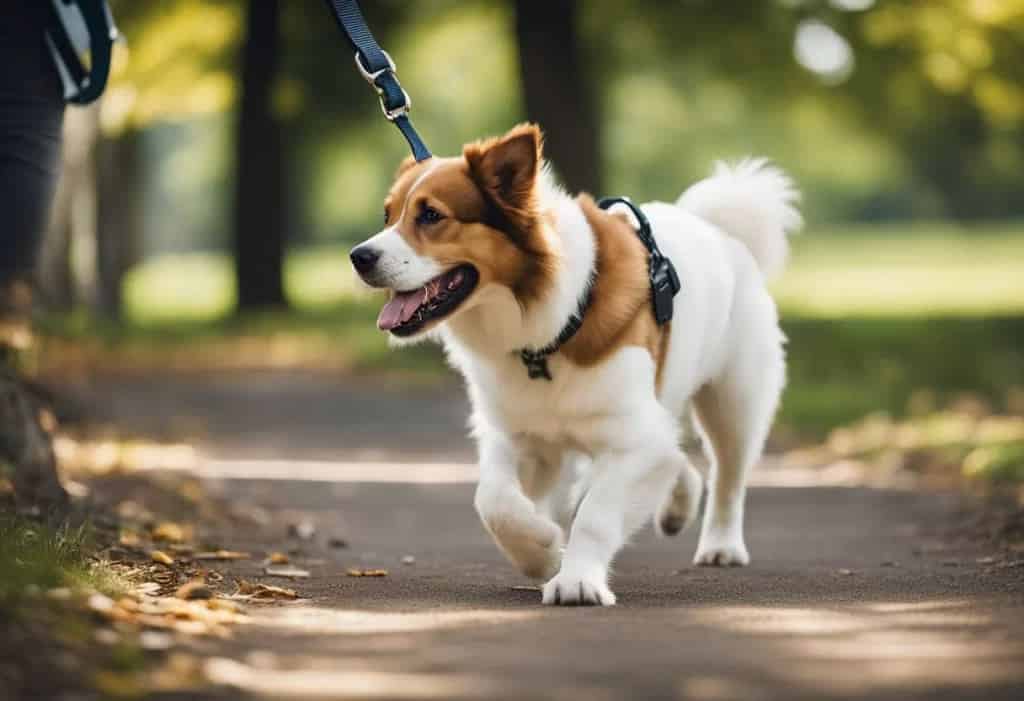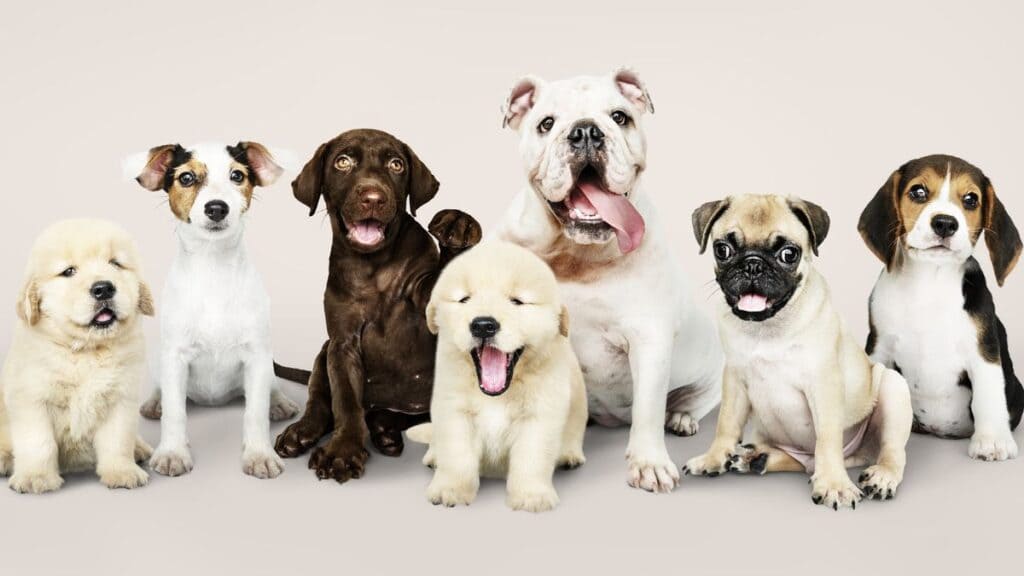Table of Contents
Hello folks! Do you have a furry companion in your house and want to bring out the best manners in them? Well, you can do it through a dog board and train program, or teaching them basic commands. But it won’t do any good if your pet is leash-reactive. Addressing this issue is important because it is so common, and on-leash walks are a part of the owner’s routine. Now, imagine the frustration when your dog begins to react aggressively or bark in front of other people or dogs. This could be a little embarrassing, too. So, this article will discuss how to fix the leash reactive dog efficiently. If you want your furry fellows to remain calm, follow our guide.

What is Leash Reactivity and Leash Reactive Dog?
When a dog on a leash displays reactive behaviors like barking and lunging, it’s known as leash reactivity. The dogs feel anxious and start displaying weird behaviors. These behaviors are frequently triggered by the presence of other dogs or strangers. Stress signs, such as stiff body language and vocalizations, such as growling or barking, are common in leash-reactive dogs. In addition to teaching your dog to handle these situations with calmness, it’s critical to identify the underlying reason for their sensitivity, which may be fear or frustration. When your reactive dog starts showing reactive behaviors, it’s important to handle the situation with composure and steer clear of conflict. To change this tendency, positive reinforcement strategies that emphasize attentional rerouting and rewarding desired behaviors might be used. Effective training for leash reactivity in dogs is based on gradual desensitization and counterconditioning; consistency and patience are essential.

Causes of Leash Reactivity
You should know that leash reactivity in dogs is caused by many underlying reasons. If you want to train your reactive dogs, the first thing you have to do is find out the possible reason, be it stress, anxiety, or any other. Once you get to know the cause, you can easily train them to be a little calm in unfavorable circumstances.
Dogs’ reactivity when on a leash might have several underlying causes, such as:
1. Fear and Anxiety Lead to Leash Reactive Dog
When faced with new people, animals, or situations, dogs may become reactive when wearing a leash out of anxiety or fear.
2. Lack of Socialization Causes Leash Reactive Dog
Fear-based responses in adult life can stem from a puppy’s limited exposure to a variety of stimuli throughout their early years.
3. Leash Reactive Dog Due to Past Trauma
As a defensive mechanism, dogs who have experienced unpleasant events in the past, including being attacked by another dog while wearing a leash, may become leash-reactive.
4. Frustration Causing Reactivity
Out of frustration, dogs who are kept from approaching objects of interest, like squirrels or other dogs, may act out in a reactive manner.
5. Overstimulation: One of the Main Causes of Leash Reactive Dog
Reactive reactions can result from high levels of excitement or emotion, which are frequently made worse by tight leash tension.
6. Genetic Predisposition in Leash Reactive Dog
Although appropriate training and management can lessen this trait, certain breeds or individual dogs may be genetically predisposed to reactivity.
7. Medical Issues Leading to Leash Reactive Dog
When a dog is on a leash, pain or discomfort caused by an accident or underlying medical condition can make it more reactive.
Identifying the precise causes of a dog’s leash reactivity is essential to creating a behavior modification strategy that works and is customized for their requirements.
If you want to know about reactive dog training tips, read this blog.

Solutions for Leash Reactive Dog
There are several simple fixes and solutions when it comes to leash reactivity in dogs. Once you get to know why your dog is reactive on a leash, the very step you have to do is try out these simple solutions that this section of the blog will cover.
1. Positive Reinforcement Training in Leash Reactive Dog
The first phase in leash reactive dog training implies positive reinforcement. The time your dog becomes reactive, use food, toys, or verbal praise to reinforce desired actions, such as walking calmly while wearing a leash. Reward your dog right away when they behave calmly to help them learn that being calm is associated with good things. Your dog feels rewarded and tends to calm down.
2. Desensitization and Counterconditioning for Leash Reactive Dog
If your dog is reactive on a leash, try out desensitization or counterconditioning. Expose your dog to a distance where they stay quiet, and gradually introduce stimuli to them. Then, associate these triggers with enjoyable activities or treats. After that, gradually increase the exposure over time to assist your dog in learning to identify triggers with good emotions rather than anxiety or annoyance.
Ø Counter-Conditioning
A behavior modification method called counterconditioning is used with leash-reactive dogs to change the dog’s emotional response to situations or people that usually cause reactive behavior. The intention is to foster a positive association with the trigger in place of the dog’s negative one.
The dog is exposed to the trigger during counterconditioning from a distance where they are comfortable and quiet. When the trigger is present, the owner gives the dog something fun to do, like playtime or expensive treats. The rewarding experience progressively replaces the negative emotional reaction by forming a new, positive association with the trigger.
The dog eventually learns to be calm around the trigger and loses their reactivity as long as it is continuously associated with happy experiences. To get long-lasting effects, counterconditioning is frequently used in conjunction with desensitization, which involves exposing the dog to the trigger progressively at progressively higher intensities.
Ø Desensitization
For leash-reactive dogs, desensitization involves introducing triggers gradually and systematically in a way that usually results in reactive behavior. Triggers are introduced gradually and at a distance where the dog stays calm. The dog is rewarded for being composed. As the dog gains the ability to remain composed in the face of stimuli that are used to cause reactive reactions, the intensity of the triggers is progressively increased over time. Throughout the procedure, consistency, tolerance, and close observation of the dog’s body language are essential. The intensity of the triggers is lowered until the dog is able to relax once more if signs of stress or reactivity appear. Desensitization can make a leash-reactive dog more at ease and less reactive with regular practice, which will make walks with the dog and their owner more pleasurable and relaxing.
3. Clicker Training Makes Leash Reactive Dog a Calm Fellow
The next simple fix if your dog’s leash reactivity is getting worse is trying out a clicker. Use a clicker to show good behavior, like maintaining composure when walking the dog, and then give a treat. The clicker helps your dog learn which behaviors result in rewards by providing a constant signal that the behavior was appropriate.
For leash-reactive dogs, clicker training means marking desired behaviors, including maintaining composure while wearing a leash, with a clicker, a tiny, small gadget that makes a distinctive clicking sound. The clicker is used to precisely mark the instant that the dog exhibits the desired behavior, such as ignoring triggers or strolling peacefully, and a reward is given right away. The training process is made easier, and good behavior is encouraged during walks when there is clear communication between you and your dog about which behaviors are rewarded.
4. Focus Commands for the Leash Reactive Dog
Your reactive dog with a leash might need focus commands to calm down. Train your dog to focus on you instead of triggers by teaching them commands like “watch me” or “look at me.” When you walk your dog and practice these instructions, praise them for maintaining eye contact with you rather than reacting to outside distractions. Doing this will stop leash reactivity in dogs.
5. Engage-Disengage Game for Leash Reactive Dog
another simple solution for your reactive dog on a leash is engaging them in a game. In this game, you give your dog a treat when they glance back at you after willingly disengaging from a trigger. Reward your dog for looking back at you when they see the trigger from a distance and stay calm. When your dog gets more at ease, gradually shorten the distance.
6. Try Out Lose Leash Walking for Leash Reactive Dog
For training reactive dogs on a leash, it is advisable to try out the loose method. Train your dog to walk politely without pulling or lunging while wearing a loose leash. Reward your dog for walking behind you; if they tug, stop them from going forward. To reinforce this behavior when out on walks, be consistent with this simple yet effective fix.
7. Avoidance is a Powerful Technique for Leash-Reactive Dog
Reactive dog leash training involves this phase to calm them down. Try to keep your dog away from situations that set them off in a reactive manner. This keeps things from getting too stressful and keeps walking associated with good things.
8. Distance Management
To keep your dog from getting overstimulated or reactive, keep a safe distance from triggers when you take them for walks. Reduce the distance gradually as your dog grows more at ease and self-assured.
9. Appropriate Equipment
To safely manage your dog’s movements and refocus their attention while out on a walk, use equipment such as head halters or front-clip harnesses. Make sure your dog is comfortable and that the equipment fits correctly. This is one of the important tips to manage the least-reactive dog.
10. Consistency and Patience
Exercise patience as your dog makes improvement and consistency in your training efforts. It may take some time to address leash reactivity, so be committed to consistently practicing these methods and acknowledge your little progress.

How to Identify if Your Dog is Leash Reactive?
There are certain ways through which you can identify if your fellow is leash-reactive. You can watch out for certain behaviors in your dog when exposed to a number of strange and unfamiliar situations. Let’s delve deep into the ways to identify if your dog is leash-reactive.
1. Pulling on the Leash
When faced with triggers, leash-reactive dogs frequently show a strong, forward pull on the leash. The need to approach or confront the trigger is what is causing this pulling, and this may be a sign of reactivity.
2. Barking or Growling
It’s obvious that a dog is reactive when it barks or growls while on a leash, especially when it’s in reaction to certain triggers like other dogs or strangers. These vocalizations are used to communicate discomfort or hostility or to warn.
3. Stiff Body Language
Tense muscles, a straight posture, and raised claws are some examples of stiff and inflexible body language displayed by leash-reactive canines. This increased tension and consciousness indicate that the dog is prepared to defend itself.
4. Aggressive Posturing
Leash-reactive dogs may adopt aggressive postures, like lunging forward, snapping jaws, or snarling. These actions are meant to frighten away or repel imagined enemies.
5. Hyper-Vigilance
Dogs that react badly to leashes frequently exhibit hypervigilant behavior, continually glancing around them for possible triggers. They could seem tense or hypervigilant as if they are expecting something to happen.
6. Difficulty Calming Down
Leash-reactive dogs may find it difficult to relax after coming into contact with a trigger, continuing to be tense or reactive long after the trigger has passed. This difficulty unwinding suggests persistent tension or alertness.
7. Increased Reactivity Over Time
Underlying leash reactivity problems may be indicated if a dog’s reactivity gets worse over time or in particular circumstances. Recurringly bad encounters or ineffective intervention may be the cause of this escalation.
Dog owners can identify leash reactivity in their dogs and take necessary action to address the problem through behavior modification approaches and training by regularly observing these behaviors during walks or encounters with triggers.

Why Is Addressing Leash Reactivity in Dogs Important?
It’s important to address dogs’ leash reactivity for a number of reasons:
1. Safety
Aggressive interactions with people, animals, or other dogs may result from leash-reactive behavior that escalates fast. Resolving this tendency lowers the possibility of accidents or confrontations when out on a walk.
2. Enjoyable Walks
Dogs and their owners may find walks stressful and uncomfortable due to leash reactivity. Walks can be made more pleasurable and stress-free for all parties by managing reactivity.
3. Socialization Opportunities
Dogs that are reactive to leashes may find it difficult to socialize with people or other dogs. They can experience positive interactions and gain confidence in a variety of settings once they have overcome their reaction.
4. Better Bonding
Patience, consistency, and positive reinforcement are necessary when training a dog to overcome leash reactivity. These techniques can fortify the link between the dog and its owner by fostering mutual trust and shared experiences.
5. Quality of Life
A dog’s general quality of life may be severely impacted by leash reactivity, which can result in stress, annoyance, and loneliness. Reactivity issues benefit the dog’s health and enable them to participate more completely in social situations and everyday activities.

Popular Dog Breeds
There are a number of dog breeds that you can select if you want to get a puppy or pet.
1. Labrador Retriever
Known for their kind nature and intellect, Labradors are gregarious and extroverted canines. Because they are devoted and easy to teach, they make wonderful family companions and are frequently utilized as therapy and assistance dogs.
2. German Shepherd
German Shepherds are adaptable, extremely intelligent canines with powerful instincts for protection. They are excellent in many capacities, including working dogs, family companions, police enforcement, and search and rescue. However, this breed can also turn out to be a leash reactive dog if exposed to unfavorable environment.
3. Golden Retriever
Admired for their intellect and loving disposition, Golden Retrievers are amiable and understanding canines. Renowned for their calm disposition and patience, particularly with young ones, they make wonderful family pets.
4. French Bulldog
French Bulldogs are robust, petite canines with endearing dispositions and characteristic “bat ears.” They make loving, playful friends and are a good fit for apartment living because they require modest exercise.
5. Bulldog
Despite their powerful physique, bulldogs are renowned for their kind and loving disposition. Despite their frightening looks, they actively devote themselves to their family, relishing spending time with them as kind companions.
6. Beagle
Beagles are lively, inquisitive canines renowned for their playful nature and acute sense of smell. They are wonderful companions for families and do best in busy homes where they may engage in outdoor pursuits like hiking or scent work.
7. Poodle
Poodles are extremely intelligent and trainable canines that come in three sizes: Standard, Miniature, and Toy. They are well-known for having hypoallergenic coats and are great companions for both adults and families.
8. Yorkshire Terrier
Also referred to as “Yorkies,” Yorkshire Terriers are energetic, tiny, self-assured canines. They are lovable companions that are well-liked by city people due to their loyalty and portability. Yorkshire can also be a leash-reactive dog if encountered with unfavorable situations.
9. Boxer
Boxers are lively, playful dogs that have a devoted and caring personality. They are great companions for busy homes because of their well-known loving demeanor toward their family.
10. Dachshund
Small dogs with a bold spirit and a characteristic elongated body are called Dachshunds. They are energetic, independent, inquisitive dogs that provide their owners with loyal and enjoyable companionship.
Any of these dogs can be leash-reactive, depending on the situation. Every one of these well-liked dog breeds has distinct traits and attributes, so when selecting a breed, it’s critical to take into account aspects like temperament, activity requirements, grooming requirements, and lifestyle compatibility.
Conclusion
To sum up, the article covered details on leash reactive dogs, the underlying causes, and how to fix this issue. If you own a pet who is a little out of control when you take him for a walk, try these simple fixes and thank us.
Lead with Love!

